There is no getting away from climate change and resource depletion in 2024. July 2024 was the warmest July ever, which means global temperatures continue rising.
Extreme heat affects billions worldwide, and severe weather is wreaking havoc everywhere.
As consumers, it may seem there is not much we can do about any of this. Still, even the smallest change in how and what we buy can contribute to saving Earth.
The environmental impact of consumer choices is significant. The trend is also extending to the furniture industry. Believe it or not, something as simple as choosing sustainable materials for a dining or coffee table can make a difference.
Many options offer environmental benefits and can make your house's interior look stunning. These include oak, walnut, copper, and more.
The Growing Demand for Sustainable Furniture
Nowadays, furniture and the materials used to make different pieces are all designed and manufactured with the environment in mind. Sustainable materials help minimize devastating impacts on ecosystems. Plus, sustainable processes help reduce waste and promote resource efficiency.
As we all become more conscious of our daily carbon footprint, we should consider purchasing sustainable furniture.
If you want to reduce your carbon footprint, sustainable materials can help. You can use sustainably sourced materials and furniture in your home and office.
Tables, in particular, are some of the most frequently used furniture in businesses and homes. Switching to sustainable table materials can make a huge difference in terms of protecting the environment.
Why Sustainable Materials Matter
Furniture production in the U.S. has a massive impact on the environment. In 2018, the furniture industry generated over 12 million tons of waste, of which only 0.3% was recycled. This means 10 million tons of furniture ended up in landfills.
Moreover, traditional furniture still mainly relies on non-renewable resources. They require harmful chemicals, and the manufacturing process uses a lot of energy.
This means a significant contribution to pollution and waste. The furniture manufacturing industry is responsible for global deforestation, which equals the loss of millions of hectares of forest annually. Deforestation accounts for at least 10% of the planet's greenhouse gas emissions. Deforestation is also one of the main causes of climate change.
Additionally, traditional furniture production means one piece of furniture can generate more than 47kg of carbon depending on the materials and manufacturing processes.
Conversely, sustainable materials are sourced and processed using strategies and processes that reduce these negative effects. For instance, sustainably harvested wood can help reduce carbon emissions.
Using recycled materials like copper can also reduce energy consumption compared to newly mined materials.
Therefore, by choosing sustainable table materials, you can help preserve natural resources and support ethical manufacturing that helps reduce greenhouse gas emissions.
Best Options for Sustainable Table Materials
As mentioned above, there are lots of options when it comes to sustainable table materials.
Gorgeous Walnut Wood
Walnut, for instance, is a popular choice for many consumers. In addition to being a beautiful, rich wood, walnut is sustainable when responsibly sourced.
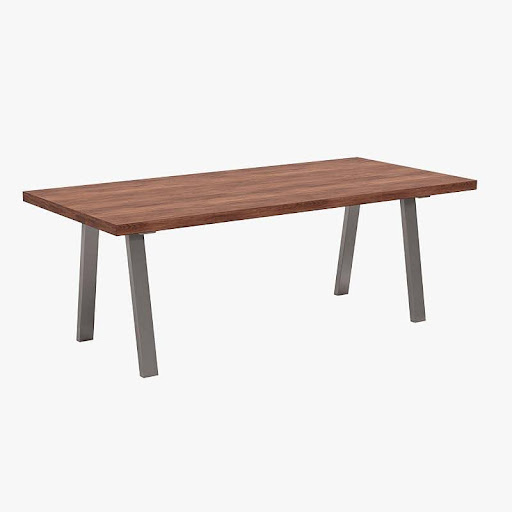
Responsible Walnut Harvesting
Walnut trees are often grown in managed forests. These forests are cultivated using sustainable harvesting practices. This means the trees are cut down in such a way that allows the forest to regenerate. A forest that can regenerate can keep its ecological balance intact.
These practices help protect forests and ensure their longevity. In most cases, it also means that future generations will continue to invest in and enjoy walnut furniture.
Walnut Wood Is Exceptionally Durable
You will struggle to find a more durable table than walnut wood. Walnut tables can last for decades and are highly resistant to wear and tear. This means you do not have to replace your table too often, minimizing waste.
Carbon Sequestration
Like all trees, walnut trees absorb carbon dioxide from the atmosphere. This process is called carbon sequestration. It helps to reduce the amount of greenhouse gases in the atmosphere, which in turn helps to reduce climate change.
When walnut wood tables are in your house, the carbon remains in the wood. This means your tables continue to contribute to the environment throughout their lifespan.
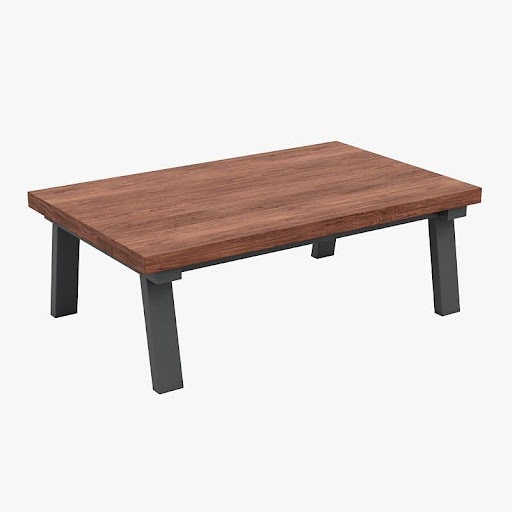
Biodegradability
Walnut wood is also biodegradable. At the end of its life cycle, walnut wood breaks down naturally without harming the environment. This starkly contrasts synthetic furniture materials like plastic, which can stay in the environment for decades if not centuries.
Strong Oak Wood
Like walnut, oak is a hardwood. This table (and other furniture) material has long been valued for its beauty and strength. If responsibly sourced, oak is also a sustainable table material.
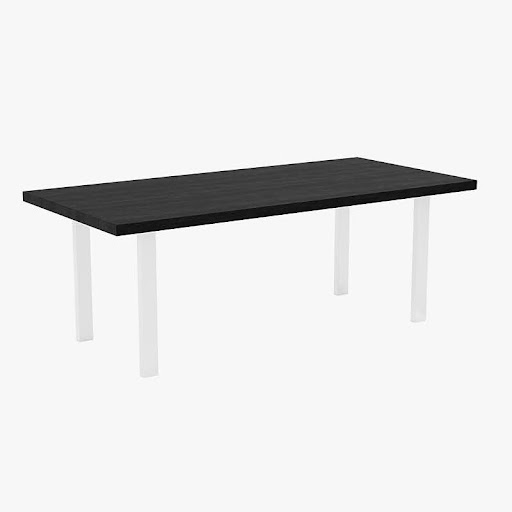
Sustainable Oak Forestry
Many oak tree forests are also sustainably managed. Those responsible for harvesting use logging, replanting, and habitat preservation measures to protect these forests. This ensures biodiversity and reduces deforestation.
Oak is also durable and can withstand heavy use and damage. Oak is an excellent choice if you want a table that you do not have to replace within a year.
Pest and Decay Resistant
Oak is naturally resistant to pests and decay, requiring fewer chemical treatments. Fewer treatments also mean a lesser chance of chemicals leaching into the atmosphere and adding to existing pollution.
Carbon Absorption
Oak trees are one of the best species for absorbing carbon because they have large canopies and dense wood. As with walnut trees, the CO2 sequestration continues after an oak is cut down. The carbon stays locked in the wood for many decades.
Recyclability and Reusability
Oak wood is highly recyclable and can be used for other purposes when its lifespan as furniture is over. This helps reduce the demand for new raw materials while minimizing waste.
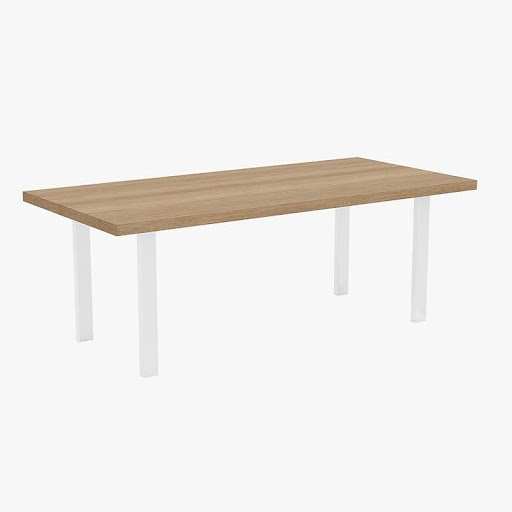
Copper as a Sustainable Option for Tables
Sustainable wood may be an obvious choice for tables, but there are other choices. You can also use copper for table surfaces or metal accents. Copper can add both a unique and sustainable touch to furniture design. Copper is also gorgeous and can transform any room.
Copper Recycling
Copper is one of the world's most recyclable metals. It is 100% recyclable without loss of quality. If you have copper tables, you can recycle and reuse the copper indefinitely. This reduces the need for new copper mining while conserving natural resources.
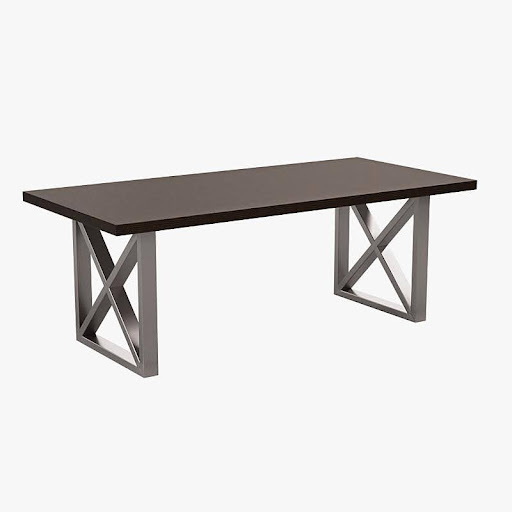
Energy Efficiency
Recycling copper also requires much less energy than producing new copper—around 85%, to be exact. Less energy means lower greenhouse gas emissions, making recycled copper a more environmentally friendly option.
Longevity
Copper has a long lifespan and is highly resistant to corrosion. You can enjoy your copper tables for many years without worrying about deterioration, and you will also save some money on replacements.
Moreover, copper may not biodegrade like wood but does not release harmful substances into the environment when disposed of properly. Plus, because copper is a high-value metal, it is far less likely that it would end up in a landfill in the first place.
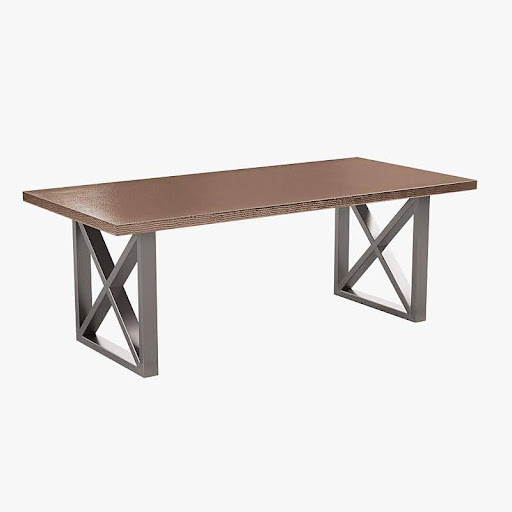
Unique Aesthetic
There is also no reason to use chemical treatments on copper if you want the metal's natural patina to develop. The patina follows the copper's aging process, enhancing the metal's beauty.
The Impact of Sustainable Material Choices
Choosing sustainable table materials goes beyond improving your immediate environment. It impacts your broader community, local economy, and even the world.
Ethical Supply Chains
When you choose tables made from sustainable materials, you also support ethical sourcing and production practices. Companies committed to sustainable production often treat their workers better and adhere to environmental regulations, which can help contribute to the well-being of local communities.
Supporting Biodiversity
When you buy sustainably, you also support green forestry practices. You are actively helping to protect habitats and biodiversity. This is crucial for the upkeep of healthy ecosystems. When ecosystems thrive, so do plant and animal species.
Reducing Waste and Resource Depletion
Sustainable material harvesting and production protect natural resources, reducing the depletion of finite resources like minerals. Choosing recycled materials also helps ensure that they are available to future generations.
Ongoing Innovation
If you join the demand for sustainable furniture, you can help push innovation in the industry. Manufacturers will want to keep up with this demand, so they will continuously develop new materials and production techniques that prioritize sustainability.
This is a win-win situation because you are helping the environment heal and getting long-lasting, stunning furniture.
Furthermore, every sustainable purchase means more consumers want to be environmentally responsible. Other companies will catch on and adopt more sustainable practices. This cycle can help establish a culture of sustainability.
Choosing Sustainable Table Materials
If you are looking for sustainable tables for your home or office, you would benefit from considering the following elements:
- Certification: Several furniture pieces, including tables and table materials, are certified by reputable organizations. This indicates that the furniture's wood comes from responsibly managed forests.
- Transparency: Ideally, you want to buy tables from manufacturers who are transparent about the materials they use. You should also be able to inquire about their sourcing practices.
- Recycled materials: You can invest in tables and other furniture that incorporate recycled materials, such as copper or reclaimed wood.
- Local production: Buying locally made tables can reduce the carbon footprint associated with transportation. At the same time, you can support local artisans and manufacturers and contribute to the local economy.
A Holistic Approach to Sustainable Furniture
Every decision you make as a consumer impacts someone else and the environment in some way. This is why it is important to consider how sustainable the materials in your home are. The tables where your family gathers can become a symbol of your commitment to sustainability.
In your workplace, sustainable tables will show your customers you are serious about reducing your carbon footprint.
Choosing walnut, oak, or copper for your tables is more than a trend. It represents an effort to reduce environmental harm—an effort that the planet can very much benefit from.
You can also bring this effort closer to home and turn it into something valuable for your family. For example, sustainable tables can become heirloom pieces passed down through your family's generations. This is a great way to promote sustainability (by reducing waste) while creating a family legacy.
Committing to a Sustainable Future
Choosing sustainable table materials is only the beginning. Every product or furniture piece you invest in should help save the planet, and each purchasing decision you make should promote and support local economies.
So, the next time you gather around a table, let it be around one made with sustainable materials. Your furniture can remind you of the impact one good choice can have on your community and the rest of the world. Finally, let it inspire you to advocate for sustainability so that our only planet's resources remain preserved for those who come after us.

